火车地发展史(英语)
火车的发展史(英语)

火车的开展史很久以前,只有马车,没有火车,人类的生活节奏很慢,所能到达的地方很近,世界的流动性很小。
PART 1 蒸汽时代18世纪初,随着社会生产力的开展,人们急需一种比马车装得多、跑得快的新型车辆。
在这种情况下,英国人瓦特创造了蒸汽机。
这种机器比马的力气可大多了,它一问世就引起了人们的注意。
1814年,英国人史蒂芬·创造了世界上第一台蒸汽机车,从此开场,人类加快了进入工业时代的脚步,蒸汽机车成为这个时代文化和社会进步的重要标志和关键工具。
1876年7月3日,中国第一条铁路——“淞沪铁路〞〔窄轨〕建成通车,那台英制名曰“先导号〞的蒸汽机车〔机车总重量1420kg〕时速为24—32公里,为我国第一台外国蒸汽机车。
1881年11月8日,建成了中国第一条自办铁路——“唐胥铁路〞〔至胥各庄〕。
第二次世界大战以后,蒸汽机车由于热效率低,已大局部被热效率高的柴油机车和电力机车所代替。
1952年,四方机车车辆厂制造出了中国第一台“解放〞型蒸汽机车。
其后,四方、、、等机车车辆厂陆续生产了近万台蒸汽机车。
蒸汽机车一度成为中国铁路运输的主要牵引动力。
1988年12月21日,机车厂停止蒸汽机车生产,标志着中国蒸汽机车制造史的完毕。
随着科学技术的进步,蒸汽机车已被燃、电力机车、动车组取代。
中国制造的蒸汽机车主要有:解放型胜利型FD型前进型上游型PART 2 燃机时代“巨龙号〞燃机车制造年份:1958年火车时速:100公里/小时中国第一台自己制造的燃机车是1958年机车车辆工厂仿照前联T3型电传动燃机车试制成功的。
它就是“巨龙〞号电传动燃机车,后经过改良设计定型,命名为东风型并成批生产。
同年,二七机车厂试制成功“建立〞号电传动燃机车,戚墅堰机车车辆厂试制成功“先行〞号电传动燃机车,但这两种车都没有批量生产。
四方机车车辆工厂也于1958年开场设计,1959年试制成功中国第一台液力传动燃机车,当时命名为“卫星〞号,代号NY1。
火车的发展史

火车的发展史
火车的发展史可以追溯到18世纪和19世纪初,以下是火车的主要发展阶段:
1.蒸汽火车时期(1804年-1910年):在1804年,英国工程师
Richard Trevithick设计了第一辆蒸汽火车。
这种火车使用
蒸汽机来驱动车轮,使其行驶在铁轨上。
19世纪初,蒸汽火
车已经被广泛应用于旅行和运输领域。
2.电力火车时期(1892年-至今):在19世纪末,电力火车开
始出现,使用电力来代替蒸汽机驱动车轮。
电力火车更加环
保、安静和高效,适用于长途旅行和货物运输。
电力火车的发展也带动了电力工业的发展。
3.磁悬浮列车时期(1964年-至今):磁悬浮列车使用磁力悬浮
技术,使列车与轨道之间的接触面减少到最小,减少了摩擦和噪音,并且具备更高的速度和更好的加速性能。
目前,磁悬浮列车已经成为许多城市的交通方式之一。
4.高速列车时期(2000年代-至今):高速列车是一种以高速行
驶为主要特点的列车。
中国的高速铁路系统已经发展成为世界上最大的高速铁路网之一,许多国家也在不断发展高速铁路系统。
随着技术的不断创新和进步,未来的火车将会更加环保、更加快速、更加安全和更加智能化。
火车将继续为人们提供高效的交通方式,促进全球经济的发展和人民生活水平的提高。
英国火车发展史

英国火车发展史
英国火车发展史可以追溯到19世纪初的工业革命时期。
以下是一些重要的里程碑事件:
1. 1804年:英国工程师Richard Trevithick设计并制造了第一辆实用的蒸汽火车。
然而,这辆火车的商业运营并不成功。
2. 1825年:世界上第一条公共铁路——斯托克顿和达灵顿铁路在英格兰开通。
这条铁路主要用于运输煤炭,并采用了蒸汽火车作为动力。
3. 1830年:世界上第一条主要用于乘坐旅客的铁路——利物浦和曼彻斯特铁路在英格兰开通。
这条铁路标志着英国火车运输业的真正开端。
4. 1840年代:英国各地开始兴建铁路网,以满足日益增长的需求。
这一时期被称为“铁路热潮”,百余家铁路公司在全国各地开通了铁路线路。
5. 1850年代:英国实施铁路国有化。
由于铁路公司的不断竞争和破产,政府决定将所有铁路公司统一管理,成立了国家铁路公司(British Railways)。
6. 1923年:英国铁路公司进一步合并,形成了四个主要的铁路公司:伦敦和北部铁路、南部铁路、大西部铁路和英国铁路公司。
7. 1948年:英国政府将国家铁路公司(British Railways)国有化,成立了国有集团British Rail。
8. 1994年:英国政府决定私有化国有的British Rail,并创立了一些私营铁路公司负责各地铁路运营。
自那时以来,英国的铁路系统经历了一系列改革和改进,包括引入高速列车(如“国家铁路公司的Intercity 125”和“英国西海岸的Pendolino”)、建设地铁系统(如伦敦地铁)和改善通信和信号技术。
冀教版英语八年级上册 Lesson 32 Trains Go Fast!

_w_a_s_b_o_r_n_i_n_ England. railways. People built many _w_h_e_e_l_s_ in the
It travelled only about train stations to help
future. That
_f_if_te_e_n__k_il_o_m_e_t_re_s__ in passengersg_e_t_o_n__a_n_d_o_f_f would be
Fill in the Speed of the Train.
the fastest trains
In 1804,the first train engine was born in England. It
500km _______t1r8a2v5el,tlhede
only about fifteen kilometres in two first passenger railway opened. The
In 1825, the first _p_a_s_se_n_g_e_r _ra_il_w_a_y_opened.
high-speed train高铁
Today’s high-speed trains can travel at about 300 kilometres per hour.
每,每一
Many countries had railways.
during the 1830s after 50 years
A scientist in England put steam and wheels together, the stream train appeared.
Countries all over the world started to build railways.
英语《Trains Go Faster!》Go with Transportation! [2]PP
![英语《Trains Go Faster!》Go with Transportation! [2]PP](https://img.taocdn.com/s3/m/0a58832b9e31433238689302.png)
in the 1700s
in the 1760s
in 1804
in 1825
during the 1830s
after 50 years (in the 1880s)
任务型阅读 What happened at that time?
Time
What happened?
in the 1700s in the 1760s
3.How fast do today’s trains go? Today’s high-speed trains can travel at about 300 kilometers per hour. The fastest train can go about 500 kilometers an hour. 4. What might future train be like? Maybe trains will have no wheels in the future and ride on air.
Let’s Do It!
1.Read again and answer the questions.
1.Where was the first train engine built?
In England.
2.When did the first passenger railway open? In 1825.
a top speed = a full speed 全速,最高速度
have a speed of…= …at a speed of … 以...的速度
The train has a speed of 300 kilometres per hour.
=The train travels at a speed of 300 kilometres per hour.
英国铁路发展史

英国铁路发展史摘要1688年,英国的资产阶级发动“光荣革命”,宣告了资本主义制度的诞生。
新的生产关系解放了生产力。
手工工场日益精密的技术分工,使各个生产过程简单化到能够用机器代替手工劳动,使手工工人的技术趋于专门化,这都为机器的发明和应用创造了良好的条件。
工业革命拉开了序幕。
工业革命首先是从纺织行业开始的。
在纺织行业中,大机器生产逐步取得了主导地位。
机器的发明和应用,蒸汽机应运而生,随后利用蒸汽机的原理制造出在公路上跑的蒸汽车,也就是后来的汽车。
几十年后,能在轨道上运行的蒸汽火车头问世。
1825年9月27日,世界上第一条行驶蒸汽机车的永久性公用运输设施,英国斯托克顿——达灵顿的铁路正式通车了。
在盛况空前的通车典礼上,由机车、煤水车、32辆货车和1辆客车组成的载重量约90吨的“旅行”号列车,由设计者斯蒂芬森亲自驾驶,上午9点从伊库拉因车站出发,下午3点47分到达斯托克顿,共运行了31.8公里。
斯托克顿——达灵顿铁路的正式开业运营,标志了近代铁路运输业的开端。
铁路以其迅速、便利、经济等优点,深受人们的重视。
在它的发源地英国自不必说,修筑铁路成为最热门、最时髦的事情。
19世纪50年代是英国铁路修建的高潮时期,1880年主要的线路基本完成,1890年全国性铁路网已形成,路网总长达32000公里。
关键词英国铁路发展铁路私有化正文英国是世界铁路运输的鼻祖,曾经有过辉煌的历史。
1814年斯蒂芬孙发明了蒸汽机车,1825年英国就开始了铁路运输。
但如今,英国铁路陷入了有史以来最困难的时期之一,以至于政府不得不承认英国交通系统存在严重问题。
这是多种因素长期发展的结果,且仍处于发展变化之中。
英国铁路的构架以及变迁英国铁路发展到今天,走完了私有———国有———私有的大循环,其不同之处是后一个私有化较前一个具有更深的政府干预的色彩。
1830 年~1947年,英国铁路经历了蓬勃发展、自由竞争、弱肉强食而走向多头垄断,最后以全行业性亏损而终结。
英国火车发展史
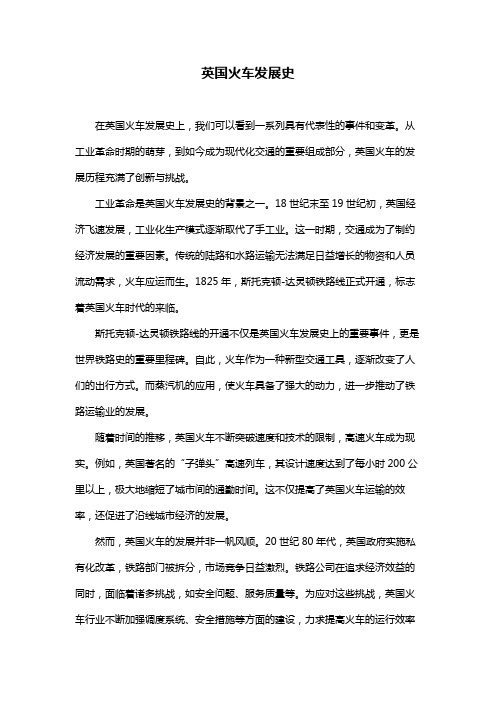
英国火车发展史在英国火车发展史上,我们可以看到一系列具有代表性的事件和变革。
从工业革命时期的萌芽,到如今成为现代化交通的重要组成部分,英国火车的发展历程充满了创新与挑战。
工业革命是英国火车发展史的背景之一。
18世纪末至19世纪初,英国经济飞速发展,工业化生产模式逐渐取代了手工业。
这一时期,交通成为了制约经济发展的重要因素。
传统的陆路和水路运输无法满足日益增长的物资和人员流动需求,火车应运而生。
1825年,斯托克顿-达灵顿铁路线正式开通,标志着英国火车时代的来临。
斯托克顿-达灵顿铁路线的开通不仅是英国火车发展史上的重要事件,更是世界铁路史的重要里程碑。
自此,火车作为一种新型交通工具,逐渐改变了人们的出行方式。
而蒸汽机的应用,使火车具备了强大的动力,进一步推动了铁路运输业的发展。
随着时间的推移,英国火车不断突破速度和技术的限制,高速火车成为现实。
例如,英国著名的“子弹头”高速列车,其设计速度达到了每小时200公里以上,极大地缩短了城市间的通勤时间。
这不仅提高了英国火车运输的效率,还促进了沿线城市经济的发展。
然而,英国火车的发展并非一帆风顺。
20世纪80年代,英国政府实施私有化改革,铁路部门被拆分,市场竞争日益激烈。
铁路公司在追求经济效益的同时,面临着诸多挑战,如安全问题、服务质量等。
为应对这些挑战,英国火车行业不断加强调度系统、安全措施等方面的建设,力求提高火车的运行效率和安全性。
展望未来,英国火车将迎来高铁时代。
目前正在建设中的英国高铁线路将进一步提高铁路运输的速度和效率。
此外,英国火车行业还在数字化转型方面取得重要进展,如推行智能化售票、实时信息查询等。
在环保和可持续发展方面,英国火车行业也在积极探索,如推广电动车、减少碳排放等。
总之,英国火车发展史是一部充满创新与挑战的历程。
从蒸汽机到高铁,从私有化改革到数字化转型,英国火车在不断适应时代发展的同时,也为其他国家提供了宝贵的经验和启示。
英语作文 物品发展史

英语作文物品发展史英文回答:Throughout history, the development of items has been a fascinating journey. From ancient times to modern days, items have evolved and improved in various ways to meet the needs and desires of people.Let's take the example of the telephone. In the past, people used to communicate through letters or messengers, which could take days or even weeks to reach the recipient. With the invention of the telephone by Alexander GrahamBell in 1876, communication became much faster and more convenient. People could now talk to each other in real-time, no matter the distance between them. Over time, telephones have evolved from bulky rotary dial phones to sleek and portable smartphones that can do much more than just make calls.Another example is the evolution of transportation. Inthe past, people used to travel by foot, horse, or carriage. With the invention of the steam engine in the 18th century, trains became a popular mode of transportation. Then came the automobile, which revolutionized the way people traveled. Today, we have high-speed trains, airplanes, and electric cars that make traveling faster and more efficient than ever before.It's incredible to see how items have developed over time to make our lives easier and more enjoyable. From the simple tools used by our ancestors to the advanced technology we have today, items have come a long way in meeting our needs and improving our quality of life.中文回答:物品的发展史是一个令人着迷的旅程。
《Trains Go Faster!》Go with Transportation! PP

The first train engine was born in England.
in 1825
The first passenger railway opened.
during the 1830s
Coutries all over the world started to build railways.
got up
got to
get on
get down
3.The Rocket had a top speed of only 45 kilometres per hour. 火箭号的最高时速只有45千米。(1)a top speed 中的top 意思“最高的”,speed意思“速度”;“以…..的速度”常用介词at 来表示。(2)per 意思”每一”,与each意思相近。 45 kilometers per hour= 45 kilometers an/ one hour at a high / low speed 以高/低速 at the speed of ….. 以……的速度Eg.声音的传播速度是每秒340米。 The sound goes 340 meters second.
在16世纪20年代
在11世纪70年代早期
in the 1290s/1290’s
2.People built many train stations to helppassengers get on and get off the trains easily. to help passengers get on and get off the trains easily作people built many train stations的目的状语。get on / off ( the bus , train, plane, ship…)上下车,而上下小轿车,电梯要用get into, get out of含有get的词组还有:get up 起床; get to 到达;get down 下来 (1)I early this morning and school on time. (2) Don’t push others when you the bus.(3) The boy climbed up a tree and couldn’t ______.
英国火车发展史
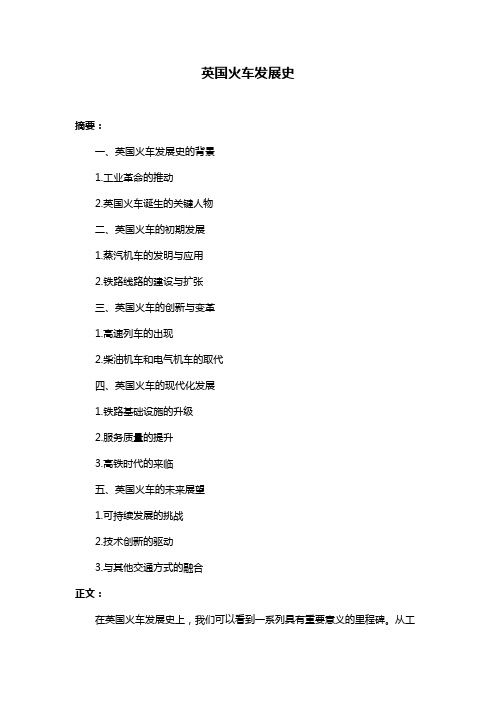
英国火车发展史摘要:一、英国火车发展史的背景1.工业革命的推动2.英国火车诞生的关键人物二、英国火车的初期发展1.蒸汽机车的发明与应用2.铁路线路的建设与扩张三、英国火车的创新与变革1.高速列车的出现2.柴油机车和电气机车的取代四、英国火车的现代化发展1.铁路基础设施的升级2.服务质量的提升3.高铁时代的来临五、英国火车的未来展望1.可持续发展的挑战2.技术创新的驱动3.与其他交通方式的融合正文:在英国火车发展史上,我们可以看到一系列具有重要意义的里程碑。
从工业革命的推动,到高速列车的出现,再到现代化发展的铁路基础设施升级,英国火车的发展历程不仅体现了技术的进步,也见证了社会经济的变革。
工业革命是英国火车发展史的重要背景。
18世纪末至19世纪初,英国正处于工业革命的巅峰时期,这一时期的英国,科技创新和生产力得到了前所未有的提升。
在这样的背景下,英国火车应运而生。
1825年,英国工程师斯蒂芬森发明了世界上第一辆蒸汽机车,并成功进行了试运行。
这标志着英国火车的诞生,也开启了铁路交通的新时代。
在火车初期发展阶段,蒸汽机车的发明与应用成为了关键因素。
随着斯蒂芬森的蒸汽机车成功运行,越来越多的铁路线路开始在英国各地建设。
这些铁路线路不仅连接了各大城市,还推动了英国经济的快速发展。
然而,蒸汽机车的噪音、烟雾和速度限制使其在很大程度上无法满足日益增长的交通需求。
于是,英国火车开始寻求新的技术突破。
20世纪初,高速列车在英国火车历史上崭露头角。
此类列车采用了流线型设计,降低了空气阻力,使得行驶速度得到了显著提升。
同时,柴油机车和电气机车的出现,也逐渐取代了传统的蒸汽机车,为英国火车带来了更高效、环保的动力来源。
随着现代化发展,英国火车在基础设施、服务质量等方面都得到了长足的进步。
铁路线路的不断升级,使得火车行驶速度得到了进一步提高。
此外,英国政府还积极投资于铁路交通,以提高服务质量。
如今,高铁时代已经来临,英国火车正以更快的速度、更舒适的体验服务于广大乘客。
英国火车发展史
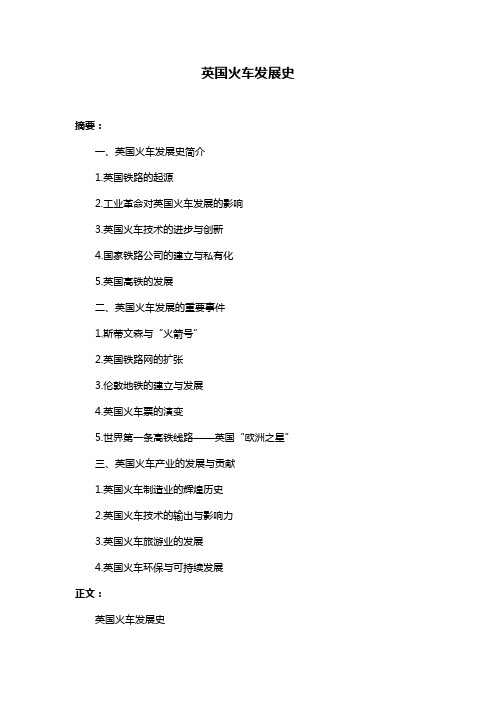
英国火车发展史摘要:一、英国火车发展史简介1.英国铁路的起源2.工业革命对英国火车发展的影响3.英国火车技术的进步与创新4.国家铁路公司的建立与私有化5.英国高铁的发展二、英国火车发展的重要事件1.斯蒂文森与“火箭号”2.英国铁路网的扩张3.伦敦地铁的建立与发展4.英国火车票的演变5.世界第一条高铁线路——英国“欧洲之星”三、英国火车产业的发展与贡献1.英国火车制造业的辉煌历史2.英国火车技术的输出与影响力3.英国火车旅游业的发展4.英国火车环保与可持续发展正文:英国火车发展史一、英国火车发展史简介英国作为世界上最早发展铁路运输的国家之一,其火车发展史可追溯到19 世纪初。
经过两百多年的发展,英国火车不仅在技术上取得了显著的进步,还对国家经济、社会、文化产生了深远的影响。
1.英国铁路的起源英国的第一条铁路诞生于1825 年,从此开启了英国铁路运输的历史。
最早的铁路主要用于运输煤炭,随后逐渐发展为客运和货运等多种用途。
2.工业革命对英国火车发展的影响工业革命期间,英国火车得到了迅速发展,成为推动国家工业化进程的重要力量。
铁路网的扩张为工厂之间的原材料和产品运输提供了便利,大大降低了运输成本。
3.英国火车技术的进步与创新从蒸汽机车到电力机车,从柴油机车到高铁列车,英国火车在技术上不断创新,引领着世界铁路技术的发展。
其中,斯蒂文森发明的“火箭号”火车极大地提高了火车运行速度和安全性。
4.国家铁路公司的建立与私有化英国政府在19 世纪末建立了国家铁路公司,对铁路运输进行统一管理。
然而,在20 世纪末,英国政府又将铁路运输私有化,以提高运输效率和竞争力。
5.英国高铁的发展英国首条高铁线路“欧洲之星”于1994 年投入运营,标志着英国铁路进入了高速时代。
高铁的发展不仅拉近了城市间的距离,还促进了英国经济和文化的交流。
二、英国火车发展的重要事件1.斯蒂文森与“火箭号”英国工程师乔治·斯蒂文森在19 世纪初期发明了“火箭号”火车,这是世界上第一辆实际可行的蒸汽机车。
世界火车的发展史

世界火车的发展史
世界火车的发展史可以追溯到19世纪初,以下是一个简要的概述:
1. 早期的蒸汽机车(19世纪初):第一列商业运行的蒸汽火车是英国的“Rocket”,于1829年投入使用。
蒸汽机车的引入标志着火车的时代的开始。
2. 铁路网络的扩展(19世纪中叶):19世纪中叶,铁路网络在英国、美国、欧洲大陆等地迅速扩展。
铁路系统的建设大大加速了交通运输的速度和效率。
3. 转向轮的发明(19世纪中叶):由约瑟夫·勒邦提出的转向轮的发明,使得火车能够更容易地在曲线上行驶,提高了列车的运行稳定性。
4. 电力火车的出现(19世纪末):电力火车的问世进一步提高了火车的效率和速度。
首个商业化运营的电气化铁路出现在19世纪末的英国。
5. 高速铁路的发展(20世纪):20世纪,高速铁路技术的发展在日本、法国、德国等国家迅速崛起。
高速铁路以更快的速度连接城市,成为现代化交通系统的一部分。
6. 磁悬浮列车(21世纪初):磁悬浮列车是一种基于磁力悬浮技术的高
速交通工具,可以实现更高的运行速度。
在21世纪初,中国开始建设并运营磁悬浮列车。
7. 智能化和自动化(21世纪):现代火车系统越来越趋向于智能化和自动化。
许多地铁、轻轨和一些高铁线路已经引入了自动列车控制系统。
总体而言,世界火车的发展历程见证了技术的飞速进步,从蒸汽机车到高速磁悬浮列车,火车在连接城市和促进经济发展方面发挥着重要的作用。
手机火车汉字发展史英文版
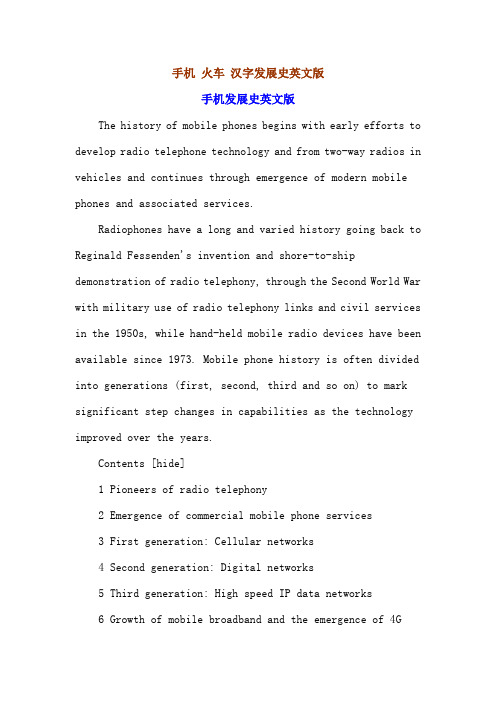
手机火车汉字发展史英文版手机发展史英文版The history of mobile phones begins with early efforts to develop radio telephone technology and from two-way radios in vehicles and continues through emergence of modern mobile phones and associated services.Radiophones have a long and varied history going back to Reginald Fessenden's invention and shore-to-ship demonstration of radio telephony, through the Second World War with military use of radio telephony links and civil services in the 1950s, while hand-held mobile radio devices have been available since 1973. Mobile phone history is often divided into generations (first, second, third and so on) to mark significant step changes in capabilities as the technology improved over the years.Contents [hide]1 Pioneers of radio telephony2 Emergence of commercial mobile phone services3 First generation: Cellular networks4 Second generation: Digital networks5 Third generation: High speed IP data networks6 Growth of mobile broadband and the emergence of 4G7 Patents8 See also9 Notes10 References11 External links[edit] Pioneers of radio telephonyIn 1908, . Patent 887,357 for a wireless telephone was issued to Nathan B. Stubblefield of Murray, Kentucky. He applied this patent to "cave radio" telephones and not directly to cellular telephony as the term is currently understood.[1] In 1910 Lars Magnus Ericsson installed a telephone in his car, although this was not a radio telephone. While travelling across the country, he would stop at a place where telephone lines were accessible and using a pair of long electric wires he could connect to the national telephone network.[2] In Europe, radio telephony was first used on thefirst-class passenger trains between Berlin and Hamburg in 1926. At the same time, radio telephony was introduced on passenger airplanes for air traffic security. Later radio telephony was introduced on a large scale in German tanks during the Second World War. After the war German police in the British zone of occupation first used disused tank telephony equipment to runthe first radio patrol cars.[citation needed] In all of these cases the service was confined to specialists that were trained to use the equipment. In the early 1950s ships on the Rhine were among the first to use radio telephony with an untrained end customer as a user.Two-way radios (known as mobile rigs) were used in vehicles such as taxicabs, police cruisers, and ambulances, but were not mobile phones because they were not normally connected to the telephone network. Users could not dial phone numbers from their vehicles. A large community of mobile radio users, known as the mobileers, popularized the technology that would eventually give way to the mobile phone. Originally, mobile two-way radios were permanently installed in vehicles, but later versions such as the so-called transportables or "bag phones" were equipped with a cigarette lighter plug so that they could also be carried, and thus could be used as either mobile or as portable two-way radios. During the early 1940s, Motorola developed a backpacked two-way radio, the Walkie-Talkie and later developed a large hand-held two-way radio for the US military. This battery powered "Handie-Talkie" (HT) was about the size of a man's forearm.In 1946 soviet engineers G. Shapiro and I. Zaharchenko successfully tested their version of a radio mobile phone mounted inside a car. The device could connect to local telephone network with a range of up to 20 kilometers.Top of cellular telephone towerIn December 1947, Douglas H. Ring and W. Rae Young, Bell Labs engineers, proposed hexagonal cells for mobile phones in vehicles.[3] Philip T. Porter, also of Bell Labs, proposed that the cell towers be at the corners of the hexagons rather than the centers and have directional antennas that would transmit/receive in three directions (see picture at right) into three adjacent hexagon cells.[4] The technology did not exist then and the frequencies had not yet been allocated. Cellular technology was undeveloped until the 1960s, when Richard H. Frenkiel and Joel S. Engel of Bell Labs developed the electronics.During the 1950s the experiments of the pioneers started to appear as usable services across society, both commercially and culturally. In the 1954 movie Sabrina, the businessman Linus Larrabee (played by Humphrey Bogart) makes a call from the phone in the back of his limousine.In 1957 young Soviet radio engineer Leonid Kupriyanovich from Moscow created the portable mobile phone, named afterhimself as LK-1 or "radiophone".[5] This true mobile phone consisted of a relatively small-sized handset equipped with an antenna and rotary dial, and communicated with a base station. Kupriyanovich's "radiophone" had 3 kilogram of total weight, could operate up to 20 or 30 kilometers, and had 20 or 30 hours of battery lifespan. LK-1 and its layout was depicted in popular Soviet magazines as Nauka i zhizn, 8, 1957, p. 49, Yuniy technik, 7, 1957, p. 43–44. Engineer Kupriyanovich patented his mobile phone in the same year 1957 (author's certificate (USSR Patent) # 115494, The base station of LK-1 (called ATR, or Automated Telephone Radiostation) could connect to local telephone network and serve several customers.In 1958, Kupriyanovich resized his "radiophone" to "pocket" version. The weight of improved "light" handset was about 500 grams.In 1967, each mobile phone had to stay within the cell area serviced by one base station throughout the phone call. This did not provide continuity of automatic telephone service to mobile phones moving through several cell areas.In 1969, a patent for a wireless phone using an acoustic coupler for incoming calls was issued in US Patent Number3,449,750 to George Sweigert of Euclid, Ohio on June 10, 1969. Dialing a number for outgoing calls was not provided.The concepts of frequency reuse and handoff, as well as a number of other concepts that formed the basis of modern cell phone technology, were described in the 1970s. In 1970 Amos E. Joel, Jr., another Bell Labs engineer,[6] invented an automatic "call handoff" system to allow mobile phones to move through several cell areas during a single conversation without loss of conversation. Also Fluhr and Nussbaum,[7] Hachenburg et al.[8] , and . Patent 4,152,647, issued May 1, 1979 to Charles A. Gladden and Martin H. Parelman, both of Las Vegas, Nevada and assigned by them to the United States Government.汉字发展史英文版In the last 50 or so years, inscriptions have been found on pottery in a variety of locations in China such as Bànpō near Xī'ān, as well as on bone and bone marrows at Hualouzi, Chang'an County near Xi'an. These simple, often geometric marks have been frequently compared to some of the earliest known Chinese characters, on the oracle bones, and some have taken them to mean that the history of Chinese writing extends back over six millennia.However, because these marks occur singly, without any context to imply, and because they are generally extremely crude and simple, Qiú Xīguī (2000, p. 31) concluded that "we do not have any basis for stating that these constituted writing, nor is there reason to conclude that they were ancestral to Shang dynasty Chinese characters." Isolated graphs and pictures continue to be found periodically, frequently accompanied by media reports pushing back the purported beginnings of Chinese writing a few thousand years. For example, at Damaidi in Ningxia, 3,172 pictorial cliff carvings dating to 6000–5000 BC have been discovered, leading to headlines such as "Chinese writing '8,000 years old.'"[6] Similarly, archaeologists report finding a few inscribed symbols on tortoise shells at the Neolithic site of Jiahu in Henan, dated to around 6,600–6,200 BCE, leading to headlines of "'Earliest writing' found in China.[7]In his comment released to the BBC, Professor David Keightley urged caution in the latter instance, pointing to the lack of any direct cultural connection to Shāng culture, combined with gaps between them of many millennia. However, in the same BBC article, a supporting argument is provided by Dr Garman Harbottle, of the Brookhaven National Laboratory in NewYork, US, who collaborated with a team of archaeologists at the University of Science and Technology of China, in Anhui province in the discovery. Dr Harbottle points to the persistence of sign use at different sites along the Yellow River t hroughout the Neolithic and up to the Shāng period, when a complex writing system appears.[7]One group of sites of interest is the Dàwènkǒu culture sites (2800–2500 BCE, only one millennium earlier than the early Shāng culture sites, and positioned so as to be plausibly albeit indirectly ancestral to the Shāng). There, a few inscribed pottery and jade pieces have been found,[8] one of which combines pictorial elements (resembling, according to some, a sun, moon or clouds, and fire or a mountain) in a stack which brings to mind the compounding of elements in Chinese characters. Major scholars are divided in their interpretation of such inscribed symbols. Some, such as Yú Xǐngwú,[9] Táng Lán[10] and Lǐ Xuéqín,[11] have identified these with specific Chinese characters. Others such as Wang Ningsheng[12] interpret them as pictorial symbols such as clan insignia, rather than writing. But in the view of Wang Ningsheng, "True writing begins when it represents sounds and consists of symbols that are able to record language. The few isolatedfigures found on pottery still cannot substantiate this point."[13]火车发展史的英文介绍+汉译China Railway began in the late Qing Dynasty. However, the Qing government corruption, conservative, authoritarian, but regulation of ancestors from, refused to accept new things. They built railways, the application of steam as a "淫巧often associated with", that will repair the railway "I lost dangers, harm I Tin House, hindered my feng shui", which stubbornly refused to build the railway.July 3, 1876, from Britain, the United States of collusion by British agents in China - Jardines - ostensibly carrying the construction of the Qing government to Shanghai from Wusong an "unusual road," the land without permission in China China built the first business of the railway line is completed, the opening of the Shanghai Wusong the. Subsequently, the Qing government of the two silver 285000, at 3 times the redemption payment and the removal of the railway.1879, Westernization Group leader Li order to Tangshan Kaiping coal mine to Tianjin, Tangshan奏请to the construction of the railway Beitang. The Qing government to railwaylocomotive "smoke禾稼injury, vibration sleep hills," he decided to shorten the rail, only repair a section of the Tangshan Coal to Xu, Xu芦台Coal to inter-cut canal, connecting 蓟运河to achieve Beitang Haikou; sleep in order to avoid rolling hills shock decision by horse traction vehicles.However, using horse traction vehicles can not play should be the effectiveness of the railway, in 1881 the opening of the railway Tang Xu, the Chinese workers, then an engineer with the British payment of the several design drawings, the boiler and the mine shaft lifting frame the trough of the old iron and other materials, the success of a trial-type 0-3-0 steam locomotive. This is the history of China's first locomotive manufacturing.Another argument is that China's first train a Tang Xu then Chief Engineer of the British rail thin model with the wife of George Stevenson of the famous British-made steam "No. rocket" and caused by, and It is named "China's No. rocket." But the Chinese workers in locomotive engraved on both sides of the one-stop, so they call it "The Dragon" Train.Because photos can clearly see the Rocket of China (Chinese rockets) and long word mark, so future generations have been identified this is the first Chinese-made motorcycles. However, left over from the picture we can see that this locomotivedesign specifications, manufacturing well, how can and from the waste material to create a "monster", etc. view?In 2003, the British study of Chinese railway彼得克拉什Jindal found a "China No. rocket" group photo. By comparison, one can see this photo on the "China No. rocket" and the picture kept on "China's No. rockets" are obviously different: the chimney of a small locomotive and the rates high, a thick and short; locomotive both sides of the tank before a shoe-shaped block, a; driver's cab, a tag is the № 1, a circular marker is ... ... as a result of old age, lack of information, the first Chinese-made motorcycles mystery remains uncertain and can not be the truth.China Railway Museum a collection of Taiwan and China's oldest locomotive, since it has a great body of the "0" character, it is then it is referred to as the "0" Train. Research experts concluded that after the opening of the railway Tang Xu, "in 1882, and from the United Kingdom to purchase two small 0-2-0 type (only two pairs of drive wheels) locomotive (called 0), and to participate in running." Were considered to be China The first imports of a motorcycle.Since 1881, Tang Xu railway built in 1911 to the fall of the Qing government for 30 years, is the first stage of China'srailway. This stage, the Qing government and internally as a result of Westernization Group recommends that people with lofty ideals and promote the continuous, not only changing the construction of the railway will "lose my dangers, harm I Tin House, hindered my feng shui" of understanding, but accept the lessons of the war a failure and further strengthening the understanding of Haiphong to the "opening of the railway may be the remedy for the military" finally determine the policy of railway construction, the establishment of the railway company, began planning to build a railway. 30 years, China's 18 provinces and cities in the construction of the railway of kilometers. Some of these government-run railway, some commercial, some government officials and businessmenco-organized, there is a part of Sino-foreign joint, or simply repair is a foreigner.The wheel of history to enter the Republic of China, the railway construction has changed the situation. Interim government in Nanjing in the early days of its establishment with the Ministry of Communications, also has set up the Chinese Railway Association and China National Railway Company. In 1928 from the beginning of the ruling KMT government in Nanjing, in his long rule of more than 20 years, although the developmentof a large-scale development of the railway project and the Ministry of Railways had set up the national railway undertaking unified management, but does not build the railway. Lack of the national railway branch less dry conditions, poor people in the country decline, the case of years of war has not changed. In 1949, the Chinese locomotive may have the 4069 Statistics of Taiwan, respectively, from nine countries, more than 30 factories, as many as 198 kinds of motorcycle models, it is no wonder China is known as a "locomotive State Museum." According to the information available now, with imports from the United Kingdom in 1892 to create the Double, Bershire type (type than Shell) and other locomotive.翻译:中国有铁路始于清朝末期。
英国火车发展史

英国火车发展史【原创版】目录1.英国火车发展史简介2.英国火车的初期发展3.蒸汽机的应用与火车的改进4.铁路网络的扩张与技术创新5.现代化火车与高速铁路的兴起6.英国火车发展对社会的影响正文【英国火车发展史简介】英国火车发展史可以追溯到 19 世纪初,经历了从蒸汽机到内燃机,再到现代高速铁路的几个阶段。
作为火车的发源地,英国在火车发展史上扮演了举足轻重的角色。
【英国火车的初期发展】英国火车的初期发展可以追溯到 1804 年,当时英国发明家与工程师理查德·特雷维锡克(Richard Trevithick)制造了世界上第一辆蒸汽火车。
此后,英国工程师乔治·斯蒂文森(George Stephenson)在 1825 年设计制造了第一辆商业运营的蒸汽火车,标志着英国火车发展进入了一个新阶段。
【蒸汽机的应用与火车的改进】蒸汽机的应用极大地推动了英国火车的发展。
在 19 世纪,英国的铁路网络迅速扩张,火车技术也不断改进。
1830 年,英国开通了第一条铁路客运线路,从此火车成为了英国主要的交通工具。
【铁路网络的扩张与技术创新】随着工业革命的推进,英国铁路网络不断扩张,技术也在不断创新。
19 世纪末,英国的铁路里程已经超过了 20,000 公里。
这一时期,火车速度也在不断提高,舒适度也在逐步提升。
【现代化火车与高速铁路的兴起】进入 20 世纪,英国火车发展进入了现代化阶段。
内燃机的应用使火车速度得到了极大的提升。
20 世纪 60 年代,英国开始建设高速铁路,火车的最高速度不断提高,使英国火车发展迈入了一个新纪元。
【英国火车发展对社会的影响】英国火车发展对社会产生了深远的影响。
一方面,火车成为了英国主要的交通工具,极大地促进了人员和物资的流动,推动了经济的发展;另一方面,火车的发展也改变了人们的生活方式,使出行变得更加便捷。
总之,英国火车发展史是火车技术与社会进步的缩影。
冀教初中英语八上《Lesson33LifeonWheels》[张老师]【市一等奖】优质课
![冀教初中英语八上《Lesson33LifeonWheels》[张老师]【市一等奖】优质课](https://img.taocdn.com/s3/m/faf2c1266c175f0e7cd137b3.png)
冀教版英语八年级上册教学设计Lesson 33 Life on Wheels 路北区韩城镇中学张雨晨教材分析:本单元围绕旅行和交通方式这一话题展开教学,课文从Jenny,Brain and Danny 介绍自己喜欢的旅行方式,要求学生了解如何表达出行方式,接着详细介绍了火车的发展史、交通方式的进步、Danny的发明和未来的交通,及有关表示将来时的句型。
学生在学习与旅行和交通相关内容的同时进一步扩展了有关旅行和交通的生词、习语和日常英语。
通过学习,学生、能够学会介绍自己喜欢的出行方式,学会表示可能性和不可能性的方法,学习动词不定式的用法。
进一步复习学过的一般将来时,扩充词汇,掌握有关目标和计划方面的常用语言,激发学习英语的兴趣,有利于培养想象力及用英语进行思维的能力。
学情分析: 八年级的学生有了一定的认知能力和语言基础,有了一定的英语学习习惯,大部分同学学习积极性较高,能较好地完成学习任务,但也有个别同学的理解能力和接受能力不尽人意,他们学习英语既好奇又担忧,希望能得到他人的肯定。
本节课坚持以学生为重心,分组合作学习,自主探究。
以任务为主的教学原则。
创造使用英语的机会,创设丰富多彩的教学情景,激发学生的学习兴趣,调动学生学习英语的积极性。
在教学活动中尽量让他们参与到活动中来,有更多的机会来说英语,减少他们的恐惧感,通过学生间的合作学习,降低他们的学习难度,使学生从不同的角度找到自信和愉悦,鼓励学生大胆质疑有目的的进行探究,同时提高他们综合运用语言的能力,使各层次的学生都有所收获。
教学理念:按照基础教育阶段英语课程的总体目标,在课堂教学中要注意学生语言技能、语言知识、情感态度、学习策略和文化意识的培养,让学生在获得知识和技能的过程同时学会学习和形成正确价值观。
本课是让学生思考他们的未来,考虑一下将来的生活,积极参与到语言的运用情景之中,体验合作交流的乐趣。
教学目标:知识与技能目标:知识目标:Learn and master the following expressions:Scary c arefully sick future Sentences:Tomorrow is the future . So is next week and next year. It’s adj. (for sb./of sb.) to do sth. 技能目标: 1.Enable students to express their hopes and wishes.2.Think about the life in the future and share the ideasin a small group. 过程和方法目标: 1.Enable students to express their hopes and wishes 2.H elp the students to learn to predict their future life an d their jobs. 情感态度价值观目标:Set up your ambition for your future. 教学重点:1、Some words and expressions about the future. 2、Predict their future life and jobs and the future tense. 教学难点:1、熟练运用“so+助动词/情态动词/be 动词+主语”的倒装句。
铁路发展史
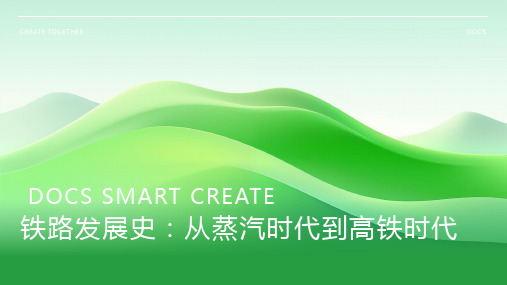
• 采用计算机技术进行铁路运营与管理
• 提高了铁路的运输能力,满足了经济
的自动化
发展的需求
• 采用现代管理理念,如效率管理、安
• 提高了铁路的安全性和运营效率,为
全管理等,提高铁路运营效率
铁路的进一步发展奠定了基础
04
高速铁路的出现与发展(20世纪中叶至今)
高速铁路的诞生与初期发展
20世纪中叶,日本率先开始研究高速铁路技术
20世纪初至20世纪中叶,铁路信号与通信技术得到了很大的发展
• 电报和电话的应用,提高了铁路的通信效率
• 信号系统的改进,如自动信号、集中控制等,提高了铁路的安全性和运营效率
铁路运营与管理的现代化
20世纪初至20世纪中叶,铁路运营与管理逐渐实现
现代化
铁路运营与管理的现代化为铁路的发展
提供了强大的动力
高速铁路在全球范围内的普及与应用
21世纪初,高速铁路开始在全球范围内普及与应用
• 亚洲、欧洲、美洲等地的国家纷纷开始修建高速铁路,如中国的京沪高铁、西班
牙的AVE等
• 高速铁路的发展为全球范围内的经济交流与合作提供了便利
高速铁路的普及与应用对铁路产生了重要影响
• 提高了铁路的运输能力,满足了经济发展的需求
谢谢观看
THANK YOU FOR WATCHING
DOCS
捷的运输方式,推动了工业化的进
铁路的运输能力得到了很大的提高
率
程
早期铁路的建设与技术难题
19世纪中叶,随着铁
路建设经验的积累,铁
路技术得到了很大的提
高
早期铁路建设面临了许多技术难题
早期铁路的建设为后来
的铁路发展奠定了基础
• 如何选择合适的铁路线路和桥梁
世界火车发展史
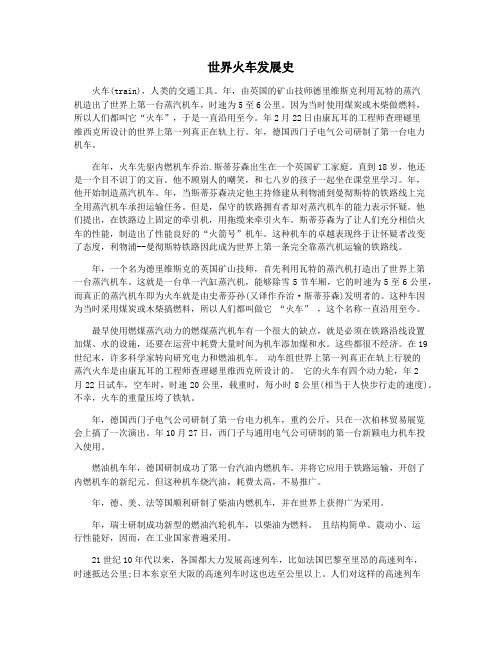
世界火车发展史火车(train),人类的交通工具。
年,由英国的矿山技师德里维斯克利用瓦特的蒸汽机造出了世界上第一台蒸汽机车,时速为5至6公里。
因为当时使用煤炭或木柴做燃料,所以人们都叫它“火车”,于是一直沿用至今。
年2月22日由康瓦耳的工程师查理礠里维西克所设计的世界上第一列真正在轨上行。
年,德国西门子电气公司研制了第一台电力机车。
在年,火车先驱内燃机车乔治.斯蒂芬森出生在一个英国矿工家庭。
直到18岁,他还是一个目不识丁的文盲。
他不顾别人的嘲笑,和七八岁的孩子一起坐在课堂里学习。
年,他开始制造蒸汽机车。
年,当斯蒂芬森决定他主持修建从利物浦到曼彻斯特的铁路线上完全用蒸汽机车承担运输任务。
但是,保守的铁路拥有者却对蒸汽机车的能力表示怀疑。
他们提出,在铁路边上固定的牵引机,用拖缆来牵引火车。
斯蒂芬森为了让人们充分相信火车的性能,制造出了性能良好的“火箭号”机车。
这种机车的卓越表现终于让怀疑者改变了态度,利物浦--曼彻斯特铁路因此成为世界上第一条完全靠蒸汽机运输的铁路线。
年,一个名为德里维斯克的英国矿山技师,首先利用瓦特的蒸汽机打造出了世界上第一台蒸汽机车。
这就是一台单一汽缸蒸汽机,能够除雪5节车厢,它的时速为5至6公里,而真正的蒸汽机车即为火车就是由史蒂芬孙(又译作乔治·斯蒂芬森)发明者的。
这种车因为当时采用煤炭或木柴搞燃料,所以人们都叫做它“火车” ,这个名称一直沿用至今。
最早使用燃煤蒸汽动力的燃煤蒸汽机车有一个很大的缺点,就是必须在铁路沿线设置加煤、水的设施,还要在运营中耗费大量时间为机车添加煤和水。
这些都很不经济。
在19世纪末,许多科学家转向研究电力和燃油机车。
动车组世界上第一列真正在轨上行驶的蒸汽火车是由康瓦耳的工程师查理礠里维西克所设计的。
它的火车有四个动力轮,年2月22日试车,空车时,时速20公里,载重时,每小时8公里(相当于人快步行走的速度)。
不幸,火车的重量压垮了铁轨。
年,德国西门子电气公司研制了第一台电力机车,重约公斤,只在一次柏林贸易展览会上搞了一次演出。
新概念英语第二册有关坐火车旅行的课文
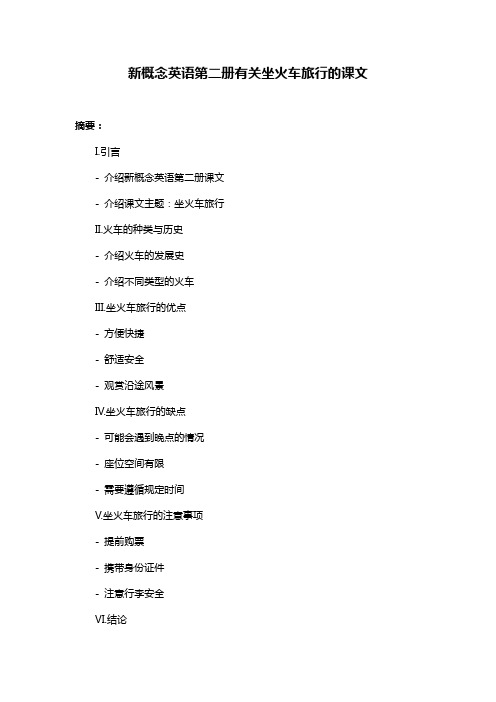
新概念英语第二册有关坐火车旅行的课文摘要:I.引言- 介绍新概念英语第二册课文- 介绍课文主题:坐火车旅行II.火车的种类与历史- 介绍火车的发展史- 介绍不同类型的火车III.坐火车旅行的优点- 方便快捷- 舒适安全- 观赏沿途风景IV.坐火车旅行的缺点- 可能会遇到晚点的情况- 座位空间有限- 需要遵循规定时间V.坐火车旅行的注意事项- 提前购票- 携带身份证件- 注意行李安全VI.结论- 总结坐火车旅行的利弊- 强调注意事项正文:新概念英语第二册的课文介绍了坐火车旅行的相关知识。
首先,课文概述了火车的种类和历史。
自从第一次工业革命以来,火车作为一种重要的交通工具逐渐发展壮大。
从蒸汽火车到电力火车,再到现在的高铁,火车的发展历程反映了人类科技的进步。
不同类型的火车有各自的特点,例如,高铁速度快、卧铺车舒适等。
坐火车旅行有很多优点。
首先,火车是一种方便快捷的交通方式。
相较于飞机和汽车,火车在长途旅行中具有更大的优势。
其次,火车旅行相对舒适安全。
火车行驶稳定,乘客可以更加轻松地欣赏沿途的风景。
最后,坐火车旅行可以让人充分感受到旅途的乐趣,特别是在一些风景优美的线路上,火车旅行成为了一种独特的体验。
然而,坐火车旅行也存在一些缺点。
首先,火车可能会遇到晚点的情况,这会给旅行计划带来一定的困扰。
其次,火车的座位空间有限,对于长途旅行来说可能会感到不适。
最后,坐火车需要遵循规定的时间,相对较为拘束。
为了更好地享受坐火车旅行的乐趣,课文还提到了一些注意事项。
首先,提前购票是非常重要的,这样可以避免在旅途中遇到没有座位的情况。
其次,携带身份证件以便在需要时进行查验。
最后,注意行李安全,尽量不要将贵重物品放在行李架上,以免遗失或被盗。
总的来说,坐火车旅行是一种兼具优点和缺点的交通方式。
火车发展史
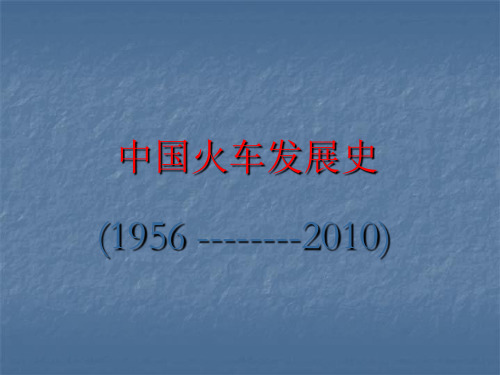
前进型蒸汽机车
前进型蒸汽机车,中国第一种自己设计的干线货运机车。1956年9月由大连工 厂试制成功,各项技术指标均达到蒸汽机车的先进水平。机车全长26063毫米, 构造速度每小时80公里,模数牵引力324千牛,轴式1—5—1。原称和平型(代 号HP),后定名为前进型,现用代号QJ。前进型机车先后由大连、长春、牡 丹江、沈阳、唐山、大同等工厂小批量生产。1964年,大同工厂对其又进行 了一系列改造,使机车的最大轮周功率达到2190千瓦,机车全长也增加到 29180毫米。1988年停止生产,共制造4708台。
HEC Marketing Dept.
上游型蒸汽机车
上游型蒸汽机车又称为上游型工矿用小型 蒸汽机车。 1960年,唐山工厂在MA6(ㄇㄎ 6)型机车的基础上改造设计并试制出第一台 上游型机车,代号SY,到目前为止共生产 1600多台。机车全长21519(21643)毫米, 构造速度每小时80公里,模数牵引力204千 牛,轴式1—4—1。
HEC Marketing Dept.
工建型蒸汽机车
工建型蒸汽机车又称工建型工矿及调车用蒸汽机车。 大连 工厂设计,太原、成都工厂1958年开始生产,1961年停产, 共制造122台。机车全长9735毫米,构造速度每小时35公里, 模数牵引力144千牛,轴式0—3—0。其他蒸汽机车还有田心 工厂生产的0—4—0型、成都工厂生产的蓉建型,代号RJ。 大连工厂1958年设计试制的红旗型,代号HQ等。除上述各 型机车外,唐山工厂1965年还根据越南的要求,设计制造了 67台,轴式为1—4—1的米轨(1000毫米)货运蒸汽机车。
HEC Marketing Dept.
第二阶段:内燃机车
北京型内燃机车。 客运,1971年-1991年生 产,部分已退役。
- 1、下载文档前请自行甄别文档内容的完整性,平台不提供额外的编辑、内容补充、找答案等附加服务。
- 2、"仅部分预览"的文档,不可在线预览部分如存在完整性等问题,可反馈申请退款(可完整预览的文档不适用该条件!)。
- 3、如文档侵犯您的权益,请联系客服反馈,我们会尽快为您处理(人工客服工作时间:9:00-18:30)。
火车的发展史很久以前,只有马车,没有火车,人类的生活节奏很慢,所能到达的地方很近,世界的流动性很小。
PART 1 蒸汽时代18世纪初,随着社会生产力的发展,人们急需一种比马车装得多、跑得快的新型车辆。
在这种情况下,英国人瓦特发明了蒸汽机。
这种机器比马的力气可大多了,它一问世就引起了人们的注意。
1814年,英国人史蒂芬·发明了世界上第一台蒸汽机车,从此开始,人类加快了进入工业时代的脚步,蒸汽机车成为这个时代文化和社会进步的重要标志和关键工具。
1876年7月3日,中国第一条铁路——“淞沪铁路”(窄轨)建成通车,那台英制名曰“先导号”的蒸汽机车(机车总重量1420kg)时速为24—32公里,为我国第一台外国蒸汽机车。
1881年11月8日,建成了中国第一条自办铁路——“唐胥铁路”(至胥各庄)。
第二次世界大战以后,蒸汽机车由于热效率低,已大部分被热效率高的柴油机车和电力机车所代替。
1952年,四方机车车辆厂制造出了中国第一台“解放”型蒸汽机车。
其后,四方、、、等机车车辆厂陆续生产了近万台蒸汽机车。
蒸汽机车一度成为中国铁路运输的主要牵引动力。
1988年12月21日,机车厂停止蒸汽机车生产,标志着中国蒸汽机车制造史的结束。
随着科学技术的进步,蒸汽机车已被燃、电力机车、动车组取代。
中国制造的蒸汽机车主要有:解放型胜利型FD型前进型上游型PART 2 燃机时代“巨龙号”燃机车制造年份:1958年火车时速:100公里/小时中国第一台自己制造的燃机车是1958年机车车辆工厂仿照前苏联T3型电传动燃机车试制成功的。
它就是“巨龙”号电传动燃机车,后经过改进设计定型,命名为东风型并成批生产。
同年,二七机车厂试制成功“建设”号电传动燃机车,戚墅堰机车车辆厂试制成功“先行”号电传动燃机车,但这两种车都没有批量生产。
四方机车车辆工厂也于1958年开始设计,1959年试制成功中国第一台液力传动燃机车,当时命名为“卫星”号,代号NY1。
后经过长期试验和多次改进,定型为东方红型,于1966年成批生产。
“东方红”1型燃机车制造年份:1964年设计时速:120公里/小时东方红1型是四方机车车辆工厂1959年试制,1964年批量生产的干线客运燃机车,机车按双机联挂设计,也可以单机使用。
前73台的机车标称功率是1060kW,最大速度140km/h,车长16550mm,轴式B-B。
后36台的机车标称功率增加到1220kW,最大速度降为120km/h,其他不变。
东风系列是电传动燃机车,也是中国燃机车的主力,保有量占国产燃机车总数的一半以上。
“东风”是个大家族,有东风、东风2、东风3、东风4系列、东风5系列、东风6、东风7系列、东风8系列、东风9、东风10系列、东风11系列、东风12、东风21米轨。
东风1型燃机车干线货运,1970年生产,现已基本退役。
“东风”4型燃机车制造时间:1974年设计时速:120公里/小时东风4型燃机车是机车车辆工厂1969年开始试制的大功率干线客货运燃机车,1974年转入批量生产。
DF4型燃机车是我国铁路运输的主力燃机车,担当着客运和货运的运输任务。
是东风系列里面,更是中国燃机车中的经典车型。
该车从首台下线使用开始距今已超过30年的历史,至今仍然在使用当中,而且数量仍然相当庞大。
即便是我国铁路已经走进铁路电气化的今天,他的地位依然没有动摇,甚至在某些地区,他仍然是运输的主力。
现在我们所见到的东风系列燃机车,基本上都是以 DF4型机车作为平台而设计制造的,可见 DF4 型燃机车在中国铁路史上有着重要的地位。
“号”燃机车制造时间:1975年设计时速:120公里/小时型燃机车是二七机车工厂1970年开始试制,1975年批量生产的四轴液力传动干线客运燃机单节型燃机车(现在中国铁道博物馆)车。
机车标称功率1500kW,最大速度120km/h,车长15045mm,轴式B-B。
型机车有3个品种,一种就是4轴单节型,这种单节的型机车被车迷昵称为“小”;另一种就是8轴双节重联型,这种双单节的型机车共生产了6组12台,被车迷昵称为“大”;第三种是6001型轴式D-D 只生产了一台,不久便拆解改造成两台“小”。
“东风”11型准高速燃机车制造时间:1992 设计时速:170公里/小时东风11型燃机车,是为广深线开行时速160公里旅客列车而研制的准高速客运燃机车。
机车标称功率3040kW,最高运行速度为170km/h。
1991年底完成试制后,先后通过了型式试验、研究性试验和15万km线路运用考核试验,最高试验速度为186km//h,牵引13辆客车,最高速度达162km/h。
1994年12月22日广深线正式开通,由东风11型燃机车担当准高速旅客列车的牵引任务。
东风11型燃机车的研制成功和大围投人运用,是我国客运燃机车技术发展新阶段的一个重要标志,开创了我国铁路客运向高速发展的新时期。
火车迷昵称为“狮子头”。
神州号燃动车组在2000年至2003年间共生产了五列,编号NZJ2 0001 - 0005,包括有机车5组10台,双层拖车4组40节。
于2000年10月18日开始投入京津城际特快运营,来往与天津之间,当时配属铁路局,机车和客车分别配属天津机务段、天津车辆段。
直到2007年4月18日,中国铁路实施第六次大提速,京津城际列车逐步更换为CRH2A型和谐号动车组,神舟号惨遭“和谐”。
2007年4月至7月期间,因新的和谐号动车组运能不足,这段时间仍然由神州号担当部分城际列车,包括西至天津北、泰达的临时列车。
至2007年7月24日起,随着和谐号动车组逐步实现重联运行,神州号全面退出京津城际特快。
NZJ2型“神州号”燃动车组是中国铁路的准高速燃动车组车款之一,属于动力集中式,采用推拉式设计。
由于车头外形和涂装的特点,神州号又被戏称为“大白猫”。
它的前一代就是NZJ1“新曙光”。
这款动车组由机车车辆厂、轨道客车车辆厂、四方机车车辆厂和铁路局联合研制,采用双层客车设计,属于动力集中式双层燃动车组,每列编组形式为2动10拖,其中双层软座车1辆、双层硬座车9辆,以头尾每端各一台柴油机车推挽式重联牵引,构造速度为180km/h,在秦客运专线上小编组(两动四拖)实验运行时最高速度达210km/h。
金轮号金轮号是在2001年由机车车辆厂、四方机车车辆厂和铁路局联合研制,主要是在神州号的基础上进行高原性增压处理、防风沙设计,以适应中国西部地区的高海拔、大风沙环境,因此金轮号也是和神州号一样使用NZJ2的编号,属于动力集中式双层燃动车组,以头尾每端各一台柴油机车推挽式重联牵引。
机车和客车车厢分别由机车车辆厂及四方机车车辆厂负责制造。
在2001年至2003年间共生产了四组金轮号列车,编号NZJ2 0006 - 0009,包括机车四组八台,客车车厢四组,其中又分为两类:两组(第一、四组)为单层客车,最初单层金轮号采用二动九拖编组,后因客流扩编至十一节拖车,车种包括硬座车(YZ25DT)、硬卧车(YW25DT)和软卧车(RW25DT);机车使用16V240ZJD型柴油机,装车功率2940 kW。
其余两组(第二、三组)为双层客车,双层金轮号采用二动六拖编组,曾经扩编至十节拖车,车种包括双层硬座车(SYZ25DT)和双层软座车(SRZ25DT);机车使用带电子燃油喷射技术的16V240ZJE 型柴油机,装车功率3310 kW。
所有金轮号均配属铁路局。
第一列金轮号是采用双层客车,于2001年7月26日起担当和之间的城际特快列车。
而单层金轮号先后运行过 - 玉门、 - 之间的管特快列车。
这个就是和神舟号同叫NZJ2的金轮号PART 3 电力时代电力机车(electric locomotive)是指由电动机驱动车轮的机车。
电力机车因为所需电能由电气化铁路供电系统的接触网或第三轨供给运行中的电力机车,所以是一种非自带能源的机车。
特点:电力机车具有功率大、过载能力强、牵引力大、速度快、整备作业时间短、维修量少、运营费用低、便于实现多机牵引、能采用再生制动以及节约能量等优点。
使用电力机车牵引车列,可以提高列车运行速度和承载重量,从而大幅度地提高铁路的运输能力和通过能力。
优点:使用电力机车的其中一个好处,在于能减少污染,包括蒸气机车、柴油机车运行时产生的废气。
供电气化铁路使用的发电厂在使用化石燃料时,均会控制废气排放,除此之外也可使用低污染的风力或水力发电。
在噪音方面,电力机车在行走时可比柴油机车静得多,同样更可进一步缩减行车时间。
缺点:电力机车的缺点在于其本身没有动力源,电能来自外部的电缆,如遇自然灾害、战争等不可抗力状况引发断电就无法运行,甚至可能引发事故。
分类:电力机车按使用场合可分为:工矿电力机车和干线电力机车两类。
工矿电力机车多采用直流制,功率和速度一般比干线电力机车小,习惯上按机车的粘着重量分级,如150吨,100吨,85吨,70吨,60吨,50吨和更轻的等级。
较大吨位机车用于标准轨距线路,较轻型的机车多用于各种窄轨距线路。
干线电力机车按用途可分为客运电力机车,货运电力机车,客货两用电力机车和调车电力机车四种。
电力动车组“先锋号”电力动车组制造时间:2001年设计速度:250公里/小时先锋号在2000年完成组装并通过了铁道部验收,2001年5月出厂。
2001年10月26日至11月16日期间在广深线进行试验,创出当时中国国最高速度的249.6km/h。
2002年9月10日在秦客运专线进行的测试中,又创出最高时速292.8公里的记录。
先锋号于2007年7月7日起到2009年9月30日开始担当成渝(-北)城际特快列车,经由达成铁路、遂渝铁路运行,最高营运速度被降至160公里/小时。
目前先锋号已经退出成渝线城际列车运行,而其地位被新配属北客运段的CRH1型动车组代替。
“中华之星”电力动车组制造年份:2002年设计时速:270公里。
2002年9月,“中华之星”动车组各节动力车及拖车于中国国家铁道试验中心环行铁道进行最后组合,并开始编组调试。
2002年11月27日,以两辆机车及三辆客车的短编组“中华之星”在新建的秦客运专线进行高速试验,其最高速度创造了当时的“中国铁路第一速”321.5km/h,成为轰动一时的时事。
“中华之星”正式配属铁路局,2005年8月1日中华之星起正式投入载客运营,担当来往及山海关的临时准高速列车,车次为L517/8次,其最高运营速度限制为160 km/h。
“和谐号”CRH1型电力动车组制造年份:2006年设计时速:250公里/小时CRH1型电力动车组,是中华人民国铁道部为进行中国铁路第六次大提速,于2004年起向庞巴迪运输和四方庞巴迪铁路运输设备订购的CRH系列高速电力动车组车款之一。
中国铁道部将所有引进国外技术、联合设计生产的中国铁路高速(CRH)车辆均命名为“和谐号”。
